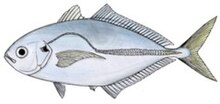
The Carangidae are a family of ray-finned fish that includes the jacks, pompanos, jack mackerels, runners, trevallies, and scads. It is the largest of the six families included within the order Carangiformes. Some authorities classify it as the only family within that order but molecular and anatomical studies indicate that there is a close relationship between this family and the five former Perciform families which make up the Carangiformes.
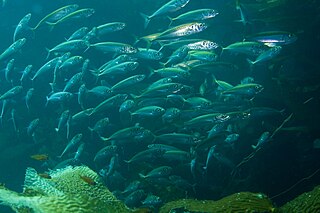
The Pacific jack mackerel, also known as the Californian jack mackerel or simply jack mackerel, is an abundant species of pelagic marine fish in the jack family, Carangidae. It is distributed along the western coast of North America, ranging from Alaska in the north to the Gulf of California in the south, inhabiting both offshore and inshore environments. The Pacific jack mackerel is a moderately large fish, growing to a maximum recorded length of 81 cm, although commonly seen below 55 cm. It is very similar in appearance to other members of its genus, Trachurus, especially T. murphyi, which was once thought to be a subspecies of T. symmetricus, and inhabits waters further south. Pacific jack mackerel travel in large schools, ranging up to 600 miles offshore and to depths of 400 m, generally moving through the upper part of the water column.

The smallmouth scad, is a species of tropical marine fish in the jack family Carangidae. The species is endemic to northern Australia, inhabiting primarily inshore waters. It is similar to other scads in the genus Alepes, and is distinguished by a well-developed posterior adipose eyelid, as well as fin membrane spotting and gill raker counts. It is not a large species, with the maximum length reported to be 29.5 cm. It feeds primarily on a variety of small invertebrates, and is of very minor economic importance.

The shrimp scad, is a species of widespread tropical marine fish of the jack family, Carangidae. The shrimp scad is widely distributed in the tropical and subtropical western Indian Ocean and areas of the eastern Pacific Ocean, ranging from South Africa in the west to Hawaii in the east, including Japan and Australia to the north and south. The species is commonly found on inshore reefs and sandy substrates. It has the common body profile of a scad, and may be difficult to differentiate from others in the genus Alepes. It is one of the larger scads, growing to 40 cm, but often is encountered at much smaller sizes. The shrimp scad often forms large schools, and is carnivorous, consuming a variety of crustaceans and small fish. It is of moderate importance to fisheries throughout its range.

The Malabar trevally, also known as the Malabar jack, Malabar kingfish or nakedshield kingfish, is a species of large inshore marine fish of the jack family, Carangidae. It is distributed throughout the Indian and west Pacific Oceans from South Africa in the west to Japan and Australia in the east, inhabiting reefs and sandy bays on the continental shelf. The Malabar trevally is similar to many of the other species in the genus Carangoides, with the number of gill rakers and the grey-brown colour of the tongue being the diagnostic features. The Malabar trevally is a predator, taking a variety of small fish, cephalopods and crustaceans. The species is of minor economic importance throughout its range, caught by a variety of net and handline methods.

The blackfin scad is a species of tropical marine fish of the jack family Carangidae. The species inhabits inshore waters throughout the Indo-Pacific region, although is rare in the western Indian Ocean. It is not a large species, with the largest reported capture being 25 cm, and it is distinguished readily from similar species by the prominent black dorsal fin. It is a predator which feeds on planktonic crustaceans, but little else is known of its biology. The blackfin scad is a minor food fish throughout its range, and is highly valued in Cambodia and Thailand.

The horse-eye jack, also known as the big-eye jack, is a game fish and minor commercial fish in the family Carangidae. Its appearance is similar to that of the crevalle jack, although the horse-eye jack's head is not as blunt. The horse-eye jack is known to feed on smaller fish and on many invertebrates, such as shrimp and crab.

The razorbelly scad is a small species of tropical marine fish in the jack family, Carangidae. The species inhabits coastal waters in the Indo-Pacific, from Pakistan in the west to Japan and Australia in the east, often found over reefs. The razorbelly scad has a complex taxonomic history, and even recently has had its position in the genus Alepes challenged, but appears to be stable after a molecular phylogeny study supported its placement in Alepes. It is very similar to other scads in the same genus, but is readily identified by its unique teeth. Razorbelly scad are predatory fish, taking a variety of crustaceans and shrimps, and show a change in feeding intensity over the year. Reproduction and development have been extensively studied in India, where spawning occurs in a single event from January to September. The species is commonly taken in tropical fisheries, where it is marketed fresh or dried.
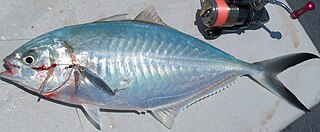
The herring scad, is a common species of tropical marine fish in the jack family Carangidae. The species inhabits the surface waters of coastal regions throughout the Indo-West Pacific region, feeding on a variety of crustaceans and small fishes. It is the largest fish of the scad genus Alepes, growing to a recorded length of 56 cm. The herring scad is identified among the genus Alepes by its more numerous and smaller scutes and the number of gill rakers on the first arch. It is of minor importance to fisheries throughout its range.

The yellowtail scad, is an abundant species of small inshore marine fish of the jack family, Carangidae. The species is widespread in the Indo-Pacific region from east Africa in the west to Hawaii in the east, extending north to Japan and south to Australia. The yellowtail scad is the only member of the monotypic genus Atule and is distinguished from similar species by a well-developed adipose eyelid and finlet-like extensions of the last rays of the dorsal and anal fins. It inhabits coastal areas such as bays and coral reefs, preying on small fishes and crustaceans. Spawning has been well studied in Hawaii, where fish enter bays to spawn, releasing up to 161,000 eggs each between March and October. The yellowtail scad is an important component of fisheries throughout its range, taken by a number of netting and hook-and-line methods. It is a prized food fish in some regions and is cooked or preserved by a variety of methods.
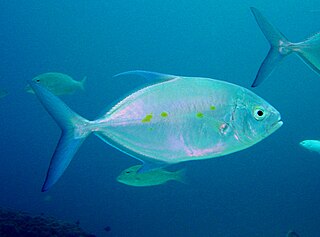
Carangoides is a genus of tropical to subtropical marine fishes in the jack family, Carangidae. They are small- to large-sized, deep-bodied fish characterised by a certain gill raker and jaw morphology, often appearing very similar to jacks in the genus Caranx. They inhabit the subtropical and tropical regions of the Indian, Pacific, and Atlantic Oceans, often occupying coastal areas, including reefs, bays, and estuaries, rarely venturing far offshore. They are all predatory fishes, taking a variety of smaller fishes, crustaceans and cephalopods as prey. The genus was first erected in 1851 by Pieter Bleeker for an unknown taxon and currently contains 20 species. Many make up significant proportions of various fisheries, although a number of ciguatera cases have been attributed to them.
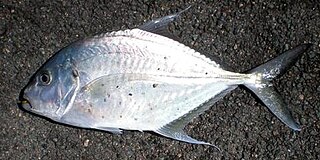
The longnose trevally, also known as the tea-leaf trevally, club-nosed trevally, grunting trevally or dusky trevally, is a species of inshore marine fish in the jack family, Carangidae. The species is distributed throughout the tropical and subtropical waters of the Indian and west Pacific Oceans from South Africa to New Zealand and Japan, inhabiting coastal waters, especially reefs, to a depth of 90 m. The longnose trevally is distinguished from similar species by a combination of a scaleless breast and the number of gill rakers and fin rays. It is a moderately large fish, growing to a maximum known length of 72 cm and 4.35 kg. The longnose trevally is a predatory fish, consuming small fish, crustaceans and molluscs. The species is of minor commercial importance throughout its range, and is considered to be a good table fish.

The threadfin jack or thread pompano is a species of coastal marine fish in the jack family Carangidae. The species inhabits the tropical waters of the eastern Pacific Ocean from Baja California in the north to Ecuador and the Galapagos Islands in the south. It is a moderately large fish, growing to 60 cm (24 in) and may be recognized by its filamentous dorsal and anal fin lobes. The threadfin jack inhabits both deeper coastal waters and inshore environments, including reefs and estuaries, where it preys on minute benthic and pelagic organisms, including small fishes and crustaceans. Very little is known about the ecology and reproductive cycle in the species. The threadfin jack is of importance to fisheries throughout its distribution, caught by hook-and-line and net methods and marketed fresh and salted, and is considered a very good table fish. The species was named Carangoides dorsalis by Theodore Gill 20 years before the name Caranx otrynter was introduced, but confusion with Vomer dorsalis led to the proposal of the new name to separate the two species.

Caranx is a genus of tropical to subtropical marine fishes in the jack family Carangidae, commonly known as jacks, trevallies and kingfishes. They are moderate- to large-sized, deep-bodied fishes which are distinguished from other carangid genera by specific gill raker, fin ray and dentition characteristics. The genus is represented in the Pacific, Indian and Atlantic Oceans, inhabiting both inshore and offshore regions, ranging from estuaries and bays to deep reefs and offshore islands. All species are powerful predators, taking a variety of fish, crustaceans and cephalopods, while they in turn are prey to larger pelagic fishes and sharks. A number of fish in the genus have a reputation as powerful gamefish and are highly sought by anglers. They often make up high amounts of the catch in various fisheries, but are generally considered poor to fair table fishes.

The blacktip trevally, also known as the blacktip kingfish or yellowtail kingfish, is a species of large marine fish classified in the jack family Carangidae. The blacktip trevally is distributed throughout the tropical to subtropical Indian and West Pacific Oceans, ranging from South Africa in the west to Fiji, Japan and northern Australia in the east. It inhabits coastal waters throughout its range, preferring moderately deep clear waters over rocky and coral reefs. The blacktip trevally is easily distinguished by its yellow fins and a dark upper caudal fin lobe which gives the species its common name, as well as a host of other anatomical features. The species is known to reach a maximum size of 1 m. It is a benthopelagic predator, commonly forming small shoals where it takes a variety of fishes, cephalopods and crustaceans as prey. Little is known of reproduction in the species, and spawning is assumed to take place in more tropical regions of its range, with juveniles known to inhabit bays and large estuaries. Blacktip trevally are often caught using hook and line and various nets in commercial fisheries although don't make up a large part of the market. They are also popular with anglers due to their fighting ability and decent table qualities.

The false scad, also known as the spotfin scad, ten-finned horse mackerel and yellow horse mackerel, is a species of medium-sized marine fish classified in the jack family Carangidae. The false scad is distributed throughout the tropical and temperate waters of the eastern Atlantic Ocean from Namibia in the south to Spain and throughout most of the Mediterranean in the north. The species has an atypical body form compared to other species of Caranx, and can be distinguished from these on its elongate 'scad-like' body shape alone. Distinguishing the species from members of Decapterus and Trachurus is more difficult, requiring detailed anatomical analysis. The false scad is known to grow to a length of 60 cm and a weight of 1 kg. The species lives both pelagically and demersally in continental shelf waters, ranging from depths of 15 to 200 m. It is a predatory fish, taking small fishes, crustaceans including euphausiids and shrimps, and cephalopods as its main prey, with significant dietary shifts as it ages. The false scad reaches sexual maturity at 2 years of age, with spawning occurring between April and July in shallow inshore waters, where the juveniles remain. The species is of major importance to fisheries throughout its range, but particularly from Morocco to Senegal, with annual catches ranging from 500 to 19000 t. The species is caught using trawls, seine nets and gill nets and sold fresh, frozen or salted.

The cocinero, also known as the barred jack and striped jack, is a species of small marine fish classified in the jack family, Carangidae. The cocinero is distributed through the tropical eastern Pacific Ocean, ranging along the west American coastline from Baja California in the north to Peru in the south. It is a pelagic species, inhabiting the upper water column in both coastal and offshore oceanic waters, occasionally making its way into estuaries. The species may be identified by its colouration, having 8 or 9 incomplete dark vertical stripes on its sides, with scute and gill raker counts also diagnostic. It is small compared to most other species of Caranx, reaching a length of 37 cm in total. The cocinero is a predatory fish, taking small fishes, crustaceans, and various benthic invertebrates in shallower waters. Little is known of the species' reproductive habits. The cocinero is of moderate importance to fisheries along the west coast of South America, and the species has been used in aquaculture trials. It is taken by various netting methods and by spear, and is sold fresh, dried, and salted at market.

Chloroscombrus is a genus containing two species of tropical to temperate water marine fish in the jack and horse mackerel family Carangidae. Both members are commonly known as bumpers or bumperfish, with one species endemic to the Atlantic and the other to the eastern Pacific. They have a convex ventral profile compared to most other carangids, with small oblique mouths and low dorsal and anal fins. Phylogenetic studies have found they are most closely related to the jacks of the genus Hemicaranx, with these genera plus Selar, Selaroides and possibly Alepes, making up a clade within the Caranginae subfamily. They are predatory fish which live in both inshore and offshore environments ranging from estuaries to the edge of the continental shelf, and are of moderate importance to fisheries.

The fringefin trevally, also called fringe-finned trevally, round-finned trevally or reef herring, is a species of inshore marine fish classified in the jack and horse mackerel family Carangidae. A relatively small fish, the fringefin trevally is known to reach 40 cm (16 in), but is mostly encountered at lengths less than 25 cm (9.8 in). The fringefin trevally has an ovate body, with distinctive orange-yellow fins and a black opercular spot. The dental patterns of the species distinguish it from the closely related scads of the genus Alepes. Males have characteristic elongated dorsal and anal fins which produce a series of trailing filaments. The fringefin trevally is restricted to the waters of the Indo-Pacific, ranging from northern Australia to Papua New Guinea and eastern Indonesia. An inshore species, it is found in coastal and estuarine environments and exhibits daily and seasonal movements. The fringefin trevally is predatory, taking crustaceans as prey. The species is often taken as bycatch in prawn trawls and occasionally taken by anglers.

The yellowstripe scad, also known as the yellowstripe trevally, yellow-banded trevally, smooth-tailed trevally, slender-scaled trevally and slender trevally, is a species of small inshore fish in the jack and horse mackerel family Carangidae, and the only member of the genus Selaroides. The yellowstripe trevally is distributed throughout the tropical waters of the Indo-West Pacific region, ranging from the Persian Gulf in the west to Vanuatu and New Caledonia in the east. The species is distinguished by its prominent lateral yellow band, and differs from the scads of the genus Selar in having a smaller eye and different dentition. Although the yellowstripe scad reaches a maximum recorded length of 22 cm, it is normally encountered at sizes less than 15 cm. Phylogenetic studies indicate the yellowstripe scad is closely related to the scads of the genus Selar, although its exact placement in the family Carangidae is less well agreed upon.




